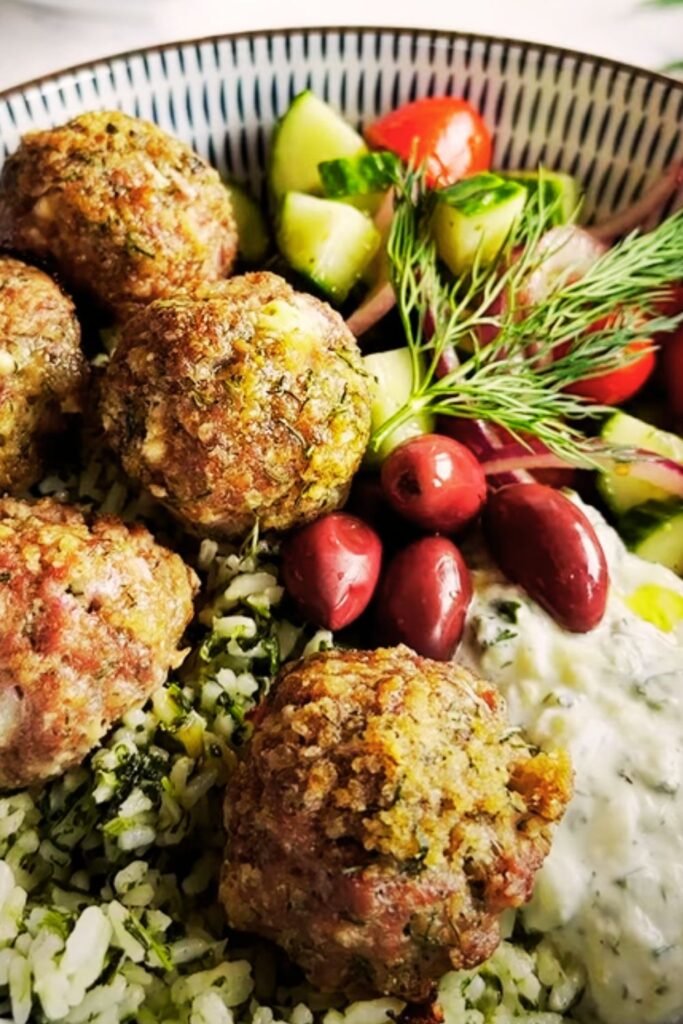There’s something magical about the way Greek cuisine combines simple ingredients into dishes that burst with flavor. I’ve spent years perfecting my Greek meatball recipe, and today I’m thrilled to share it with you! These aren’t just any meatballs—they’re keftedes, the authentic Greek version that’s crispy on the outside, juicy on the inside, and infused with Mediterranean herbs and spices that will transport you straight to a seaside taverna in Santorini.
What Makes These Greek Meatballs Special
What sets Greek meatballs apart from their Italian or Swedish counterparts? It’s all in the distinctive blend of aromatics and spices. My recipe uses fresh mint and dried oregano (staples in Greek cooking), along with garlic, onion, and a touch of cinnamon that gives these meatballs their unmistakable Greek character.
I’ve made these countless times for family gatherings, and they’re always the first dish to disappear. The secret to their irresistible texture? A bit of soaked bread mixed into the meat—a technique my Greek neighbor taught me years ago that keeps them wonderfully tender.
The History Behind Keftedes
Keftedes have been part of Greek cuisine for centuries. The word comes from the Persian “kofta,” which traveled throughout the Mediterranean and Middle East, evolving into local variations. In Greece, these meatballs became a staple of mezze platters—those delightful spreads of small dishes meant for sharing.
Traditionally, Greek families would prepare keftedes using whatever meat was available, though beef and lamb became the most common choices. Every Greek grandmother has her own closely guarded recipe, with regional variations throughout the islands and mainland. Some versions include pine nuts or raisins, while others might feature different herb combinations.
Ingredients You’ll Need
For the perfect Greek meatballs, quality ingredients make all the difference. Here’s what you’ll need:
For the Meatballs
- 1 pound ground beef (80/20 fat content works best)
- ½ pound ground lamb (for authentic flavor, but can use all beef if preferred)
- 1 medium onion, finely grated
- 3 garlic cloves, minced
- ¼ cup fresh mint leaves, finely chopped
- 2 tablespoons fresh parsley, finely chopped
- 1 tablespoon dried oregano
- 1 teaspoon ground cinnamon
- ½ teaspoon ground cumin
- 1 large egg, beaten
- 2 slices day-old bread, crusts removed
- ¼ cup milk (for soaking bread)
- ½ cup breadcrumbs (preferably Panko for extra crispiness)
- 1 teaspoon salt
- ½ teaspoon freshly ground black pepper
- Olive oil for frying
For the Tzatziki Sauce
- 2 cups Greek yogurt (full-fat)
- 1 cucumber, seeded and grated
- 3 cloves garlic, minced
- 2 tablespoons fresh dill, chopped
- 1 tablespoon extra virgin olive oil
- 1 tablespoon fresh lemon juice
- ½ teaspoon salt
Equipment Needed
I find having the right tools makes the cooking process so much smoother:
- Large mixing bowl
- Grater for onion and cucumber
- Small bowl for soaking bread
- Measuring cups and spoons
- Sharp knife and cutting board
- Heavy-bottomed skillet or frying pan
- Slotted spoon for removing meatballs
- Paper towel-lined plate for draining
- Meat thermometer (optional but helpful)
Step-by-Step Instructions
Preparing the Meatball Mixture
- Prepare the bread base: Tear the bread into small pieces and place in a bowl. Pour milk over bread and let soak for 5 minutes until soft. Then squeeze out excess milk and add the bread to a large mixing bowl.
- Mix the aromatics: Add the grated onion, minced garlic, chopped mint, parsley, dried oregano, cinnamon, and cumin to the bowl with the soaked bread.
- Add the meat: Add the ground beef and lamb to the bowl. Season with salt and pepper.
- Bind it together: Add the beaten egg to the mixture.
- Combine thoroughly: Using clean hands (the best tools for this job!), gently mix everything together until just combined. Be careful not to overmix, which can make the meatballs tough.
- Chill the mixture: Cover the bowl with plastic wrap and refrigerate for at least 30 minutes, or up to 2 hours. This helps the flavors meld and makes the mixture easier to shape.
Forming and Cooking the Meatballs

- Shape the meatballs: Remove the mixture from the refrigerator. With slightly damp hands (to prevent sticking), form the mixture into meatballs about 1½ inches in diameter. You should get approximately 24-30 meatballs.
- Coat in breadcrumbs: Place breadcrumbs in a shallow dish. Roll each meatball in breadcrumbs, shaking off excess.
- Heat the oil: In a large, heavy-bottomed skillet, heat about ¼ inch of olive oil over medium heat until shimmering.
- Fry in batches: Add meatballs in batches (don’t overcrowd the pan) and fry until golden brown on all sides and cooked through, about 8-10 minutes total. The internal temperature should reach 160°F (71°C).
- Drain: Using a slotted spoon, transfer cooked meatballs to a paper towel-lined plate to drain excess oil.
Preparing the Tzatziki Sauce
- Prep the cucumber: After grating the cucumber, place it in a clean kitchen towel and squeeze out as much liquid as possible.
- Mix ingredients: In a medium bowl, combine the Greek yogurt, drained cucumber, minced garlic, chopped dill, olive oil, lemon juice, and salt. Stir well to combine.
- Chill: Cover and refrigerate for at least 30 minutes before serving to allow flavors to develop.
Nutritional Information
For those watching their nutritional intake, here’s a breakdown of what you can expect per serving (approximately 5 meatballs with 2 tablespoons of tzatziki):
| Nutrient | Amount | % Daily Value* |
|---|---|---|
| Calories | 385 | – |
| Total Fat | 24g | 31% |
| Saturated Fat | 9g | 45% |
| Cholesterol | 105mg | 35% |
| Sodium | 620mg | 27% |
| Total Carbohydrate | 14g | 5% |
| Dietary Fiber | 2g | 7% |
| Sugars | 3g | – |
| Protein | 29g | 58% |
| Calcium | 120mg | 9% |
| Iron | 3mg | 17% |
| Potassium | 485mg | 10% |
*Based on a 2,000 calorie diet
Serving Suggestions

Greek meatballs are incredibly versatile! Here are my favorite ways to serve them:
- As a mezze: Serve with tzatziki sauce, warm pita bread, olives, and feta cheese for an authentic Greek appetizer spread.
- In a pita sandwich: Stuff warm pita bread with keftedes, tzatziki, sliced tomatoes, and red onions.
- As a main course: Pair with a Greek salad, roasted lemon potatoes, and tzatziki sauce.
- On a grain bowl: Serve over cooked quinoa or rice with roasted vegetables and a drizzle of tzatziki.
- As party finger food: Serve smaller meatballs with toothpicks and tzatziki as a dipping sauce.
- With simple sides: A squeeze of fresh lemon juice, some Greek-style roasted vegetables, and a simple side salad.
Make-Ahead and Storage Tips
These meatballs are perfect for meal prep! Here’s how to make them ahead and store them:
Make-Ahead Options
- Prepare the mixture in advance: The meatball mixture can be made up to 24 hours ahead and stored, covered, in the refrigerator.
- Form uncooked meatballs: Shape the meatballs, place them on a baking sheet lined with parchment paper, cover with plastic wrap, and refrigerate for up to 24 hours.
- Pre-cook for later: Fully cook the meatballs, cool completely, and refrigerate for up to 3 days. Reheat in a 350°F (175°C) oven for 10-15 minutes until warmed through.
Freezing Instructions
- Raw meatballs: Arrange shaped, uncooked meatballs on a baking sheet and freeze until solid, about 2 hours. Transfer to a freezer bag or container and freeze for up to 3 months. Thaw in the refrigerator before cooking.
- Cooked meatballs: Cool completely, then freeze in a single layer on a baking sheet. Once frozen, transfer to a freezer-safe container and store for up to 3 months. Reheat from frozen in a 350°F (175°C) oven for about 20 minutes.
Tzatziki Storage
Tzatziki sauce will keep in an airtight container in the refrigerator for up to 4 days. Give it a good stir before serving as some liquid separation may occur.
Tips for Perfect Greek Meatballs Every Time
Over the years, I’ve discovered some tricks that take these meatballs from good to outstanding:
- Don’t skip chilling the mixture: This step is crucial for helping the meatballs hold their shape and allowing the flavors to meld.
- Use a mix of meats: The combination of beef and lamb creates the most authentic flavor, but if you can’t find lamb or prefer not to use it, all beef works too.
- Don’t compact the meat too much: When forming the meatballs, handle the mixture gently and don’t pack it too tightly. This keeps the texture light and tender.
- Test the seasoning: Before cooking all your meatballs, fry a small test patty to check the seasoning. This way, you can adjust salt and spices if needed.
- Maintain oil temperature: Keep the oil at a consistent medium heat. If it’s too hot, the outside will burn before the inside cooks; if it’s too cool, the meatballs will absorb too much oil and become greasy.
- Consider baking option: For a healthier version, you can bake the meatballs at 400°F (200°C) for about 20-25 minutes, turning halfway through.
- Rest before serving: Let the cooked meatballs rest for 5 minutes before serving. This allows the juices to redistribute throughout the meat.
Variations to Try
While I love the classic recipe, here are some delicious variations you might enjoy:
Spicy Greek Meatballs
Add 1 teaspoon of crushed red pepper flakes to the meat mixture for a spicy kick.
Lemon-Herb Keftedes
Add the zest of one lemon to the meat mixture and increase the fresh herbs to ½ cup total.
Feta-Stuffed Meatballs
Place a small cube of feta cheese in the center of each meatball before cooking for a gooey, cheesy surprise.
Gluten-Free Version
Replace the bread and breadcrumbs with cooked and cooled quinoa or almond flour.
Turkey Keftedes
Substitute ground turkey for the beef and lamb for a lighter option. Add an extra tablespoon of olive oil to the mixture to keep them moist.
Perfect Pairings

Complete your Greek feast with these traditional accompaniments:
Side Dishes
- Greek salad with tomatoes, cucumbers, red onions, and feta
- Lemon-roasted potatoes with oregano
- Spanakopita (spinach and feta pie)
- Grilled vegetables with olive oil and lemon
- Gigantes plaki (Greek baked beans)
Desserts
- Baklava
- Greek yogurt with honey and walnuts
- Loukoumades (Greek honey puffs)
- Galaktoboureko (custard pie with phyllo)
Frequently Asked Questions
Q: Can I make these meatballs without lamb? A: Absolutely! While the beef-lamb combination gives the most authentic flavor, you can use 100% beef instead and still get delicious results. Ground turkey or chicken can also work, though they’ll have a different flavor profile.
Q: My meatballs are falling apart when I cook them. What am I doing wrong? A: This usually happens when the mixture is too wet or there isn’t enough binding agent. Make sure you’ve thoroughly squeezed the excess milk from the soaked bread, and if needed, add a bit more breadcrumbs to the mixture. Also, don’t skip the chilling step, which helps the meatballs hold together.
Q: How do I know when the meatballs are cooked through? A: The meatballs should be golden brown on all sides and reach an internal temperature of 160°F (71°C). If you don’t have a meat thermometer, cut one open – it should be brown throughout with no pink remaining.
Q: Can I bake these instead of frying? A: Yes! For a healthier version, place the formed meatballs on a parchment-lined baking sheet, spray or brush lightly with olive oil, and bake at 400°F (200°C) for 20-25 minutes, turning halfway through cooking time.
Q: My tzatziki sauce is too runny. How can I fix it? A: The key is removing as much liquid as possible from the cucumber. After grating, place the cucumber in a clean kitchen towel and squeeze firmly to extract excess moisture. If your sauce is already made and too runny, you can strain it through a fine-mesh sieve for a few hours in the refrigerator.
Q: Can I make these ahead for a party? A: Definitely! These meatballs are perfect for entertaining because they can be made ahead. Either prepare the mixture a day in advance and cook before your guests arrive, or fully cook the meatballs and reheat them in the oven at 350°F (175°C) for 10-15 minutes before serving.
Q: What herbs can I substitute if I don’t have fresh mint? A: While mint gives these meatballs their distinctive Greek flavor, you can substitute additional fresh parsley or try fresh dill as an alternative. The flavor will be different but still delicious.
Why You’ll Love This Recipe
There’s something deeply satisfying about creating a dish that has been enjoyed for generations. These Greek meatballs connect us to the rich culinary traditions of the Mediterranean, where food is not just sustenance but a celebration of life, family, and community.
What I love most about this recipe is its versatility. Whether served as an elegant appetizer at a dinner party, packed into a pita for a quick lunch, or presented as the star of a weeknight dinner, these keftedes never disappoint. Their aromatic blend of herbs and spices offers complex flavors that belie the simplicity of their preparation.
The crispy exterior giving way to a juicy, tender interior makes each bite a perfect balance of textures. And when paired with the cool, creamy tzatziki sauce, the combination is nothing short of magical.
So gather your ingredients, set aside a little time in the kitchen, and prepare to create a dish that might just become your new family favorite. These Greek meatballs aren’t just food—they’re an experience, a journey to the sunny shores of Greece that you can enjoy wherever you are.
Kali orexi! (That’s “good appetite” in Greek!)